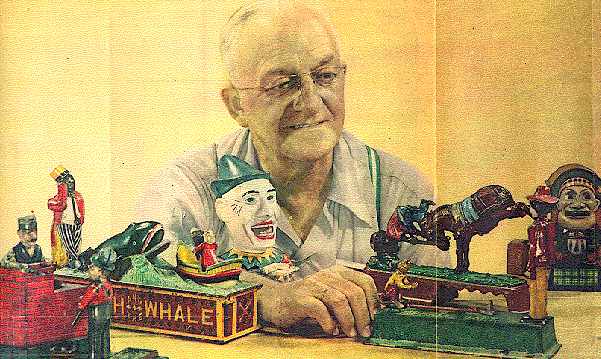THE MILWAUKEE JOURNAL, Sunday, October 2, 1949
Parlor Panhandlers
Milwaukeean Has an outstanding Toy Bank Collection

The mechanical bank which does some trickery with a penny is a bit of Americana. The banks first appeared about 1870, were many and most ingenious during the next two decades. They occasionally are still manufactured.
Walt H. Roloff, 604 N. 59th St., a chemical company official, found a cast iron Eagle and Eaglet mechanical bank in a Racine store 38 years ago. He was intrigued by the mechanism. A coin was placed in the beak of a large metal eagle. Then a lever was pressed, the coin dropped into a nest in which sat two small eagles. They opened their mouths as the coin fell. Roloff bought the bank and since then has acquired some 185 other mechanical banks plus 3,000 other cast iron, wood, tin, porcelain, milk glass, Bennington ware, pewter, pottery and bisque banks — the kind that merely have a slit to receive a coin.
Roloff, whose collection is regarded as outstanding, is an exception among toy bank collectors. For, lie postmen who go walking on their day off, most collectors are bankers. There are about 350 known types of mechanical banks, but no collector so far has accumulated all of them.
Originally the mechanical banks sold for from 75 cents to $18 a dozen wholesale. Now the cheapest collectors’ items bring from $3 to $10 each and such rarities as Harlequin, Girl on the High Chair, and Shoot the Chute have brought as much as $500 each.
Roloff’s most unusual bank is a little dog in a box which Roloff says was never put on the market. He believes his bank is the only one extant.
Penny banks represents an American era that probably never will return. They were put on the market with the idea of luring youngsters into saving through the application of "sugar coated thrift," It was believed that humorous, sporting and circus subjects would get Junior to place his coppers in these tiny cast iron vaults. Occasionally satire was a mechanical bank theme and the money grabbing of the old time Tammany machine was one of the themes followed. Roloff’s collection grew by writing antique dealers throughout the country.
